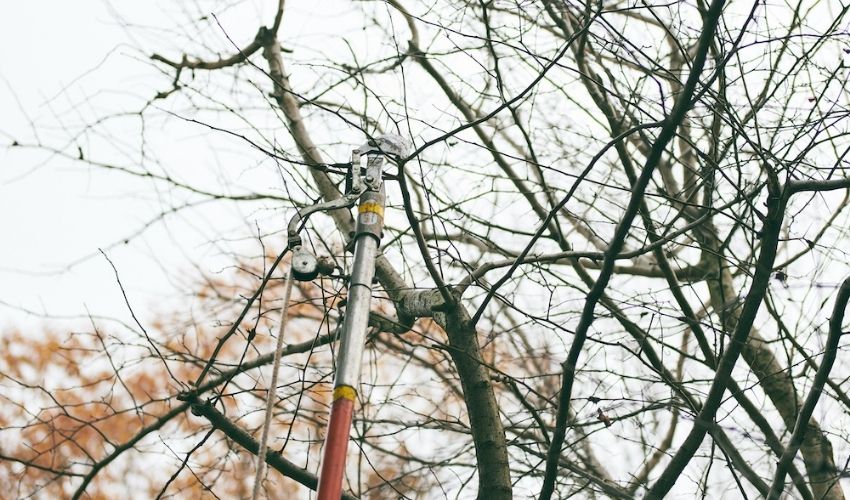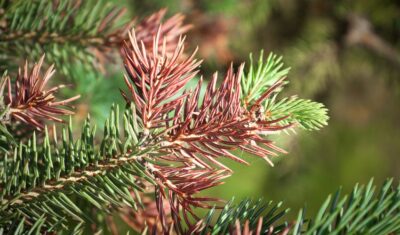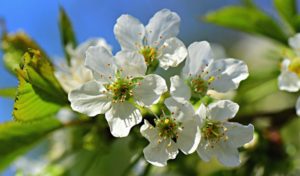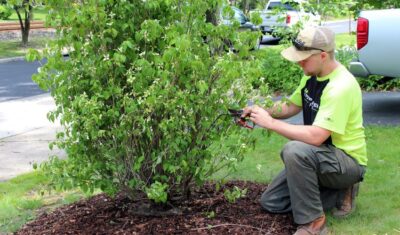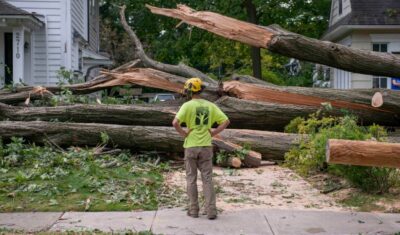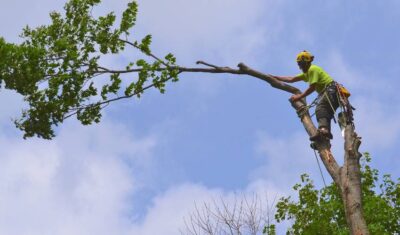We use the phrase “winter dormancy” a lot, especially when talking about why it’s good to prune trees during the winter (what we call dormant pruning).
But what does winter dormancy really mean? And why is dormancy in trees (and other plants) important?
DEFINITION - "Dormancy is a period in an organism's life cycle when growth, development, and (in animals) physical activity are temporarily stopped." (from Wikipedia)
Why do trees enter dormancy in winter?
Dormancy in plants is like winter hibernation in animals; the tree is conserving energy and living off stored nutrients to get through the long, cold Northeast Ohio winter.
During summer, when trees are actively growing, they generate “food” in the form of carbohydrates and sugars through the process of photosynthesis. Sunlight triggers the process in the tree’s leaves to turn carbon dioxide and water into carbohydrates that the tree uses for energy throughout the growing season and/or stores for use over the winter.
As temperatures cool down and days shorten in autumn, photosynthesis slows down. The tree stops actively growing. Leaves of deciduous trees change color and eventually fall off the tree, leaving it without its “food factory”. Remaining sugars and carbohydrates, as well as moisture inside the tree, move down into the roots where they are used to sustain the tree during winter dormancy.
When temperatures warm up in spring, the tree comes out of dormancy – sap flows quickly, nutrients make their way into the tree canopy, buds swell, and leaves emerge to provide food for the tree through photosynthesis.
Are there different types of dormancy in trees?
Yes, there are two types of dormant states that trees can be in during the winter.
- Endo-dormancy - This occurs when something inside the tree or plant stops it from growing. Plants in this state will not grow even under good, warm, growing conditions.
- Eco-dormancy - In this type of dormancy, the tree is ready to grow but the environmental conditions aren't right. Usually, it's because the temperature is too cold.
Trees enter endo-dormancy first; it's triggered as days shorten and temperatures fall below freezing in autumn.
How long will a tree remain dormant?
Once dormant, the tree begins to "keep track of" the number of hours during which temperatures rise above freezing. These hours are called chilling units (contrary to common belief, chilling hours does not refer to the number of hours below freezing, only those above freezing). The most effective temperatures for accumulating chill hours appear to be between freezing and 45 F, extending up to 55 F for some trees.
Different tree species have different requirements for chilling, ranging from less than 500 hours to more than 1,500 hours. For example, you may notice when buying a fruit tree, such as an apple, peach, or pear, that the plant tag specifies the number of chill hours required for the tree to reliably produce fruit.
When the tree completes its required number of chilling units, it enters eco-dormancy. At this point, it's ready to break dormancy as soon as temperatures warm up.
In Northeast Ohio, most trees will have accumulated the necessary chill hours by some time in January (although it depends on winter temperatures).
What happens if the weather warms up before the tree reaches the right number of chilling units?
If warm weather occurs before the plant completes its chilling requirement, it won't break dormancy and start growing. That's why trees don't usually begin growing during warm spells in the middle of winter (although it does sometimes happen).
However, winter temperatures above 60 F often have a negative effect on chilling, resulting in a longer dormant period.
PRO TIP - If you're trying to force spring-blooming branches to flower early by taking them indoors, don't do it too early. If the tree or shrub hasn't accumulated enough chill hours, the cut stems won't grow or bloom.
When do trees go dormant in Northeast Ohio?
Trees enter dormancy after all of the leaves have fallen and we've had several hard freezes and/or periods of freezing weather. That usually happens in Northeast Ohio around the very end of the year.
What would happen to trees in winter if they weren't dormant?
Several things would happen during freezing winter weather if trees didn’t enter dormancy:
- Water inside the tree trunk, branches and leaves would freeze, expand, and tear apart the tree from the inside out.
- The frozen ground would prevent moisture uptake, leaving the tree without the necessary moisture to sustain itself.
- The tree would have to expend tremendous energy to maintain itself (especially the leaves) during a time when short days limit the amount of photosynthesis that can occur. As a result, the tree would decline, even if it survived internal ice damage and moisture loss.
- During snow or ice events, snow- and ice-covered leaves would add tremendous weight, often leading to significant damage to the tree.
When should trees "wake up" in spring?
Trees generally start to emerge from winter dormancy when temperatures warm up into the mid-40s. That usually happens in the area around Chagrin Falls, Ohio, sometime in March.
We first notice it when buds begin to swell, although growth actually begins before that.
What happens if trees break dormancy too early?
We sometimes get extended periods of warm weather in the middle of winter. Trees that have reached their chill requirements may then begin to push out new growth.
The problem is that all of that tender new growth is highly susceptible to severe damage if temperatures suddenly drop below freezing again (as they usually do!). Because of the damage, your tree may not produce as many leaves, flowers, or fruit that spring as it usually does. You may also find that some of the branch tips and smaller stems have been killed by the sudden cold.
How can I tell if a tree is dead or just dormant?
Without leaves, it can be difficult to know whether a tree or branch is dead or just dormant.
Some things are obvious. For example, if a tree doesn’t start putting out leaves by early summer, it’s probably dead. But if buds start to swell in spring, that's a clear sign that the tree or shrub is breaking dormancy.
But during the winter or very early spring when there are no leaves on the tree, how can you tell?
Here are some easy ways to differentiate dormant wood from deadwood:
- Bend a twig. Deadwood is brittle so if the twig snaps then it’s likely dead, but if it's flexible then the plant is probably just dormant.
- Look at the color and texture of the bark. If it looks different from nearby trees of the same kind (or if a branch looks different from the rest of the tree), then it may be dead. Trees or branches that have been dead for a while often lose their bark and turn a silvery color, but if the change has only happened recently then the difference will be more subtle.
- Check for bent or broken branches. Anything beyond that point is probably dead.
You may have heard about the “scratch test” as a way to identify whether woody stems are still alive. It involves scratching the bark off a small branch to see if the wood below is grey (dead) or green (living). While it does tell you whether the branch is dead or alive, it also creates a wound that leaves an entrance for disease and decay. It’s best to reserve this method for situations where you’re fairly certain you’re dealing with deadwood.
If you're not sure whether or not your tree is dead or dormant, give us a call. Professional arborists are experienced in differentiating between the two, even when it may not be obvious to the untrained eye.
Take Advantage of Winter Dormancy
Because of the prevalence of Dutch elm disease and oak wilt here in Northeast Ohio, elm and oak trees should only be pruned during dormancy. Both diseases are carried by beetles that are attracted to fresh cuts on host trees. Pruning during winter avoids this problem.
Winter, while trees are dormant, is also an excellent time for major pruning work. For details, see this article describing six reasons to choose dormant pruning.
In Summary
Dormancy is a natural process that all cold-hardy plants go through in Northeast Ohio to help them survive our frigid winters. While we may not appreciate the look of dormant trees as much as their colorful appearance throughout the rest of the year, it’s a necessary process that gives them the energy needed to put on a show of spring blooms, lush summer greens, and brilliant fall colors.
If you're not sure whether a tree is dead or dormant, give us a call at 440-564-1374 to schedule an inspection.
Is your tree dormant...or dead?
If you're not sure whether a tree is dead or dormant, give us a call at 440-564-1374 to schedule an inspection.Recent Articles
Topics
About The Author

STAY IN THE LOOP
WITH OUR
LATEST UPDATES
"*" indicates required fields



